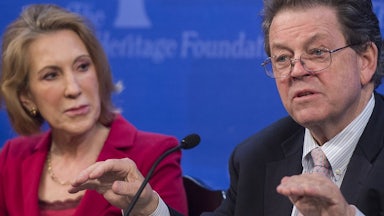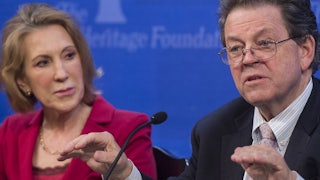Former Secretary of State George Shultz died over the weekend at age 100. He received many accolades for being one of the last sane Republicans. Shultz was from the Eisenhower era of Republican politics, which was not as obsessively ideological as today’s. Nevertheless, Schultz was responsible for radicalizing the Republican Party in one important way: He helped elevate the economist Arthur Laffer as a central figure in Republican economic policy. Shultz brought Laffer to Washington to work for him in 1971, when Shultz was a Cabinet official in Richard Nixon’s White House.
Even back then, well before his name became permanently wedded to a curve purporting to show the fanciful spike in government revenues produced by steep tax cuts, Laffer was known for promulgating economic theories far outside mainstream economics.
Few people now remember that in addition to his term as secretary of state for Ronald Reagan, Shultz also served as head of three other Cabinet departments. He was secretary of the treasury, secretary of labor, and director of the Office of Management and Budget under Nixon. Prior to his government service, Shultz had been dean of the business school at the University of Chicago, where he was an expert on labor relations. Laffer also taught at the business school, where his principal interest was international trade and economics.
Laffer was a “whiz kid” who had been on the fast track from an early age. After graduating from Yale in 1963, he did graduate work in economics at Stanford. Before he had even completed his Ph.D. dissertation, he was hired and granted tenure by the University of Chicago business school—an extraordinarily rapid elevation up the academic ladder. When Shultz became director of the OMB, he asked Laffer to become the first chief economist there. In this position, Laffer was a member of the so-called Troika of federal agencies that developed the administration’s official economic forecast, which is used to calculate all budget details. (Treasury, the OMB, and the Council of Economic Advisers make up the Troika, and the CEA makes the final call on forecasts.)
During this time, Laffer was involved in a highly contentious dispute between the OMB and the CEA. Briefly, Laffer forecast a level for the gross national product of $1,065 billion for 1971. This was about $20 billion above the consensus view among forecasters. This may not sound like much today, but at the time it was politically important. Furthermore, the method by which Laffer derived his forecast was a bit cockamamie. He thought increases in the money supply translated almost instantaneously into increases in nominal GNP—a view far outside the economics mainstream. (For details, see Laffer’s 1971 articles in the Financial Analysts Journal and The Journal of Business.)
Basically, Laffer ignored everything economists normally look at when making a macroeconomic forecast, such as personal income and spending, corporate investment, the trade deficit, and so on. He looked only at the money supply. As a Wall Street Journal report on February 10, 1971, explained, “By his method, Mr. Laffer says, each one-percentage-point increase in the annual rate at which the money supply … is growing will cause the annual rate of GNP rises to speed up by one percentage point, and will do so in the same calendar quarter in which the money-supply boost occurs.”
Of course, the Laffer method tells us nothing about real GNP; it only forecasts nominal or money GNP. Normally, economists are only concerned with real GNP (now gross domestic product) because that takes out inflation and gives a better idea of national well-being and growth. But for federal budgetary purposes, nominal GNP was quite important because taxes were levied on nominal income, not real incomes. (In 1971, the tax system was not indexed to inflation.) Therefore, if you wanted to calculate tax revenues—which was critical for determining the budget deficit—you needed to use nominal GNP. With inflation rising rapidly in 1971, the Nixon administration was keen to show that the deficit was under control, which meant squeezing as much revenue out of the Troika forecast as possible.
It must have been especially painful when the economist Milton Friedman—the dean of monetarism—dismissed the Laffer model as utterly implausible. As Friedman told The Washington Post on February 14, 1971, “It is contradicted by the mass of evidence in the past.” Friedman was speaking not only as the leading Republican economist in the United States—a close adviser to both Barry Goldwater in 1964 and Richard Nixon in 1968—but also as the nation’s leading authority on monetary policy and a member of the University of Chicago economics department. (It should be noted that relations between the university’s economics department and the business school had long been chilly, with those in the business school feeling that the economics department treated them as members of the junior varsity.)
Herb Stein, a member of the CEA, was especially critical of Laffer, as were economists at the Federal Reserve, then chaired by Republican economist Arthur Burns, whose academic work was very much at odds with Laffer’s extreme version of monetarism. (Ironically, Laffer’s monetary theory has much in common with today’s Modern Monetary Theory, which is primarily promulgated by economists on the left.)
Leonard Silk of The New York Times and Hobart Rowen of The Washington Post followed the $1,065 billion controversy as closely as gossip columnists follow today’s Hollywood celebrities. (See Silk’s columns on February 3, 1971; February 10, 1971; and March 30, 1971. See Rowen’s column on February 7, 1971.) A Times news report on April 30, 1972, casually referred to the Laffer model as “a farce.” The Times even published a satirical poem about Laffer’s “money machine.”
“Laffer … claims that we can arrive / At a Gross National Product of ten sixty‐five,” it reads in part. “That is now the official forecast of the year / And it won’t be disputed, of this never fear / Because Shultz has insisted that’s what it must be / If prosperity is to return before ’seventy‐three / This puts a great strain, as will clearly be seen / On Laffer’s new magical money machine.” It’s worth reading the full poem if only to show that some economists actually have a sense of humor. (Note its author is one “A. Priori.”)
Meanwhile, back at the University of Chicago, from which Laffer was on leave, MIT professor Paul Samuelson, who had become the first American to win the Nobel Prize in economics the year before, gave a lecture ridiculing Laffer, titled, “Why They Are Laughing at Laffer.” During the speech, Samuelson referred to Laffer as “Dr. Laffer” and then abruptly corrected himself because Laffer hadn’t yet finished his dissertation or completed all the requirements for a Ph.D.
This led to considerable embarrassment at the university—and a formal investigation led by the economist George Stigler on whether Laffer had misrepresented himself as having completed his Ph.D. before he’d been hired. It concluded that the university erred in granting Laffer tenure but suggested that he had also misled the university. Said the Stigler report:
Laffer became an assistant and then an associate professor without fulfilling the known requirements for these appointments and at a very minimum permitted misunderstandings favorable to himself to persist. We consider this conduct deplorable.… This cloud of suspicion, whether of judgment or character, introduces a serious impairment of Laffer’s value to the University of Chicago.
Laffer was finally granted his Ph.D. by Stanford in 1972, and the controversy caused him to depart for the University of Southern California when his government service ended. Stigler later said that Laffer wasn’t really interested in being a scholar. “Doing painstaking, detailed work wasn’t his game. He went for quick and glamorous results,” Stigler said in 1985, when Laffer was running for the U.S. Senate from California.
Ironically, Laffer got the last laugh. By the fourth quarter of 1971, GNP was rising at an annual rate of $1,073, according to contemporary data published in the Economic Report of the President 1972. Subsequent revisions have raised GNP for all of calendar 1971 to $1,172 billion—far above the forecast that was so widely ridiculed for being absurdly high.
During the Trump era, Laffer jettisoned his long-held view on the critical importance of free trade, in order to curry favor with the protectionist president—as did his good friend Larry Kudlow, Trump’s National Economic Council director. For this and other obsequious suck-ups to Trump, Laffer received the Presidential Medal of Freedom from the president in June 2019. Unfortunately, this once-prestigious award has been seriously debased by Trump, who awarded it mainly to athletes and lickspittle supporters. At least Dolly Parton had the class to turn it down—twice!
George Shultz may have been a decent man, but he never left his indecent party, even long after crackpots like Trump, Marjorie Taylor Greene, and other extremists took control of it. As far as I know, Shultz has never voiced support for the Laffer Curve—but then again, we may never have heard of it in the first place had Shultz not given Laffer his big break.








